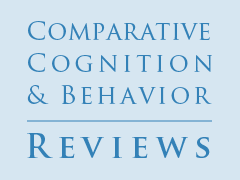
Instructions For Authors
Article types
Comparative Cognition and Behavior Reviews publishes five types of articles:
- Substantive Reviews. These are reviews of the literature on topics related to comparative cognition, broadly defined. The reviews may synthesize a body of work to provide an overview of the state of knowledge on a topic, or they may evaluate issues or theoretical approaches to a topic. The authors should strive to present the information in a way that is understandable to a broad audience.
- Brief Reviews. These articles are shorter and more narrowly focused than substantive reviews. They may review research on a more narrowly focused topic, or they may present a new perspective on a body of knowledge discuss a new trend in the field.
- Constructive Critiques. These articles provide a constructive critique of an experimental approach, a theoretical issue or position, or a trend in the field. Note that these must have a broader focus than a particular article or book. The critiques should be substantiated with well-reasoned arguments and evidence, and they should offer positive suggestions. Published commentaries of the critique will be solicited by the editors and the authors will be given the opportunity to publish a short reply to the points raised in the commentaries.
- Comparative Cognition Innovations (CCI). These articles will focus on recent trends in the field of comparative cognition. They can summarise exciting new data or simply outline new ideas that will move the field forward. The aim is to provide a forum for the communication of innovative ideas to those working in comparative cognition.
- How-To Articles. These are explanatory articles that work in two ways: they can either provide those working in the field of comparative cognition with a clear and targeted overview of another field, or provide those working in another field with a clear and relevant overview of comparative cognition. There is no limit to the subject area. The ultimate aim is to encourage more interdisciplinary discussion.
Guidelines
Prior to submission, please carefully read and follow the submission guidelines detailed below.
Submission: The submitted file format should be either Microsoft Word Format (.doc or .docx), or PDF (.pdf). Masked reviews are optional. If you want a masked review, indicate so in a cover letter. Authors should provide the mailing address for all authors on the cover page of the paper. Manuscripts should be submitted by email to the editors.
Manuscript Preparation: Prepare manuscripts according to the Publication Manual of the American Psychological Association. Personal pronouns are encouraged, except in the abstract where they are omitted. Avoid the third person and write active sentences. Follow Strunk and White’s advice in The Elements of Style when in doubt. If authors wish to do so, they can include tables, figures and figure legends as appropriate in the manuscript close to where they would appear in the published article. When a paper is accepted, a file that adheres to the standard APA-style organization of a manuscript is required.
Formatting: Double-space all copy. Use a 12-point font. Times Roman is preferred. Please use consecutive line numbering across all pages for your submitted manuscript. Tables: Use Word’s “Insert Table” function when you create tables. Avoiding using tabs or spaces.
Abstract: All manuscripts must include an abstract containing a maximum of 250 words typed on a separate page.
Keywords: Please supply up to five keywords on the cover page.
References: List references in alphabetical order. Each listed reference should be cited in text, and each text citation should be listed in the References section. The inclusion of DOIs is highly preferred. References should follow APA style.
Graphics. Graphic files are welcome if supplied as PDF, EPS, TIFF, or PowerPoint files. Multi-panel figures should be compiled into one file. The minimum line weight for line art is 0.5 point. Original figures can be printed in color (in fact, it is encouraged). Color photographs should be supplied as 300 dpi TIFF or JPG files. Separate high quality figures are strongly encouraged to be submitted with the final revised manuscript.
Video: We encourage the use of video presentations in articles. Please send video contributions as separate files in either AVI or Quicktime format.
Permissions: Authors of accepted papers must obtain and provide to the editor on final acceptance all necessary permissions to reproduce in print and electronic form any copyrighted work.
Copyright: Authors will retain copyright of their articles as outlined in our policies.
Financial Support for Open Access Publications
Each article costs $1,000 (in U.S. currency) to transform an accepted manuscript into the journal article formats we provide. In our commitment to truly open and high-quality reviews and criticisms, we do not require authors to provide this funding. Federal and institutional contributions, however, do significantly offset these costs. Any costs not provided by the authors’ institutions is supported by the Comparative Cognition Society.
